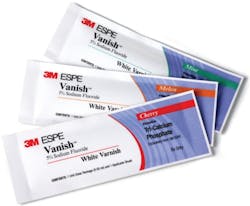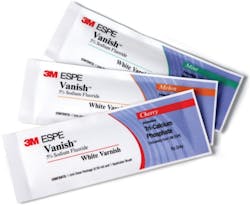Sale or rent equipment write-off limited
By Mark E. Battersby
It is a true conundrum: to depreciate or inventory? A dental manufacturer or dealer purchasing equipment for use in the business or held for rental can depreciate it, plus it qualifies for like-kind exchange treatment under our tax rules. If however, that same equipment is held out for sale, under our tax rules it is considered inventory and cannot be either depreciated or exchanged.
With many dental dealers engaged in both selling and renting new and used equipment, as well as servicing such equipment, a recently published memorandum from the Office of the Internal Revenue Service's chief counsel may answer some confusing questions: Can a dental equipment business claim depreciation deductions or qualify for like-kind exchange treatment for equipment that is both "held for sale" and designated as rental equipment?
The tax laws
The tax laws are clear: a dental dealer can claim a depreciation deduction for the exhaustion and wear and tear of property used in a trade or business or for the production of income. However, those same laws also deny depreciation deductions for inventories or stock in trade.
Another area of the tax laws allows a manufacturer or dealer to ignore gain or loss on the exchange of business property if the property is exchanged solely for property of like kind. Restrictions deny this non-recognition treatment for an exchange of property that is stock in trade or other property held primarily for sale.
The real world
Equipment rentals have increased in recent years because of the relatively high cost of new equipment, which has become increasingly more sophisticated. Many potential customers for equipment are small practices and businesses that cannot afford to purchase new equipment. Consequently, many of these practices and businesses rent or purchase equipment after it has been rented for a significant period of time and the purchase price has been substantially reduced.
Some dental dealers have a separate rental operation where equipment items are dedicated to rental. More commonly, however, a dental dealer or business will hold equipment for either sale or rental. This is usually labeled as "dual use" property.
Looking back while looking forward
In 2005, the Internal Revenue Service acknowledged that so-called "dual use" property could arise in several different situations. For example, a business can hold equipment items for sale or rent, automobile dealers can use certain cars as demonstrators, and department stores can use articles of clothing for display purposes.
Unfortunately, the IRS failed to realize that there are important differences among industries. Demonstrators and display merchandise do not generally generate separate revenue for a taxpayer engaged in the business of selling merchandise. In contrast, equipment that is rented generates rental income for the dental dealer in addition to revenue from the sale of equipment. The existence of this separate revenue stream is, at least to some dealers, an indication that they are engaged in a rental business in addition to a merchandising business.
The IRS's position remains vague. The IRS has indicated that an important factor in determining whether property is used in a taxpayer's trade or business is whether the property generates separate revenue. In a 1989 Revenue Ruling, for instance, the IRS held that houses used as models or sales offices for a small fraction of their expected useful lives, which never generate any rental income, remain inventory property and therefore cannot be depreciated.
In a 2002 memo, the IRS stated that a taxpayer's leased equipment qualified as property used in a trade or business because the taxpayer "had a bona fide, ongoing leasing operation, and was using the equipment in that operation." The taxpayer usually sold its leased equipment for substantially less than its original cost and only recovered a portion of its cost through sales revenue. What's more, most of the taxpayer's equipment was leased multiple times and was offered to customers for lease for a substantial period of time. Thus, in this situation, the IRS believed the taxpayer's leased equipment was also held for sale and did not have to be treated as inventory.
Other IRS "advice" involved leased equipment that was temporarily used in the taxpayer's business where the taxpayer at all times could withdraw the equipment from lease, and the average term equipment was leased was only six months before being sold.
In a 1989 Revenue Ruling, the IRS held that equipment was not temporarily withdrawn from inventory where the equipment, once leased, was re-leased multiple times, the taxpayer derived substantial income from its leasing activities, and the equipment leased was usually owned two to four years before being sold by the taxpayer.
As far back as 1998, the IRS stated that, "{I]f an asset can function as both merchandise held for sale and as an asset used in a trade or business, the taxpayer's primary purpose for holding that asset determines whether the asset is inventoriable."
On balance, the courts and the IRS seem to indicate that if property is withdrawn from inventory and used in a taxpayer's business for longer than one year, the property will not generally be considered "temporarily" withdrawn from inventory.
The IRS weighs in
The IRS's chief counsel recently rendered an opinion, citing the situation of a taxpayer in the business of selling, renting, servicing, and financing equipment that the taxpayer classified as "held for rental" (investment), "or held for sale" (inventory). As with many similar businesses, rental equipment that was initially classified as held for rental (investment) when purchased was often subsequently sold to a renter or other purchaser later.
There are usually no prior purchases, sale agreements, or other contracts in place with the renters stating how much of the rental payments, if any, will be applied toward the purchase price of the rental equipment. The price is negotiated at the time that the renter decides to acquire the rental equipment.
Further complicating matters, the taxpayer in the IRS's example has been structuring like-kind, Section 1031 tax deferred exchanges on the sales and dispositions of rental equipment when sold to the renters and other buyers.
Although on rare occasions the taxpayer arranged a sale or lease before acquiring the equipment, most of the new equipment acquired was available to customers for either sale or lease. The taxpayer's ultimate goal was to sell all its equipment; however, because of the nature of its business and its competitive business environment, the taxpayer often leased its equipment prior to selling it.
While using equipment during a lease caused its value to decrease, the taxpayer received income from its leases that benefited its business. The taxpayer normally reacquired the leased equipment upon the early termination or expiration of the lease and would hold it for varying periods of time before selling or re-leasing it. The taxpayer never scrapped any equipment and eventually sold all of it. The title to all equipment remained with the seller until it was sold.
Initially, the taxpayer treated the equipment as "inventory" unless the equipment had already been subject to an existing lease when the taxpayer acquired it. This treatment was not challenged.
Swaps, trade-ins, and exchanges
The business cited by the IRS's chief counsel structured its sales of "rental property" equipment as exchanges. It entered into a Master Exchange Agreement and named a qualified intermediary (QI) and a trustee, neither of which was related to the business. The business negotiates sales with customers and assigns the sales contracts to the QI.
The business routinely ordered replacement property from the manufacturer and assigned its rights to acquire the equipment to the QI. The trustee collected the proceeds from the sale of the relinquished property and made disbursements for purchases of the replacement property on behalf of the business. The replacement property was assigned an order number and entered into the business's fixed asset depreciation system. The business routinely sent a monthly statement to the QI and the manufacturer informed them of the replacement property and included the statement, "Under IRC# 1031, [Business] has assigned its rights to acquire this equipment to [QI]."
An analysis of the business's annual results showed 91% of its income was generated from "sales," while 9% was generated from its rental operation. What's more, the IRS found that a substantial amount of the equipment designated as rental equipment was sold by the business prior to the equipment generating any rental income.
The IRS speaketh
The IRS's chief counsel concluded that the rental equipment that had been classified as held for rental (investment) was not actually held for rental purposes, but was actually held as inventory in the business and was, therefore, held for sale and not investment. Temporarily withdrawing the equipment from inventory held for sale does not convert the equipment from inventory held for sale into equipment held as rental property, at least according to the IRS.
The IRS's position is that, given these or similar facts and circumstances, a business may not depreciate the equipment and cannot qualify for like-kind exchange treatment. Will your dental equipment business be affected by this latest IRS opinion? Professional advice is certainly advised for every dental equipment manufacturer and dealer.

